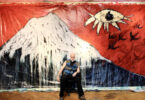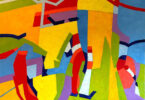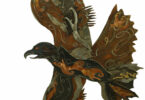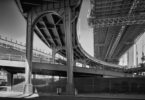I was recently privileged to view the newest works by the artist Basha
Maryanska at Jadite Gallery, in her solo show entitled “Assemblage,”
where the pieces use collage and inventive painting to realize poetic
and astonishing results.
Experiencing chaos growing up in Eastern Europe, Maryanska is happy to live in the United States without such incessant turmoil in her life. Her paintings are expressions of deep feelings and this current foray is no exception. She has confronted years of bleak shadows in the past and now, in our country’s present situation, her optimism about living here is tinged with a sense of unease as she is unsettled by our current world. These works reflect this anxiety in color choices, brushwork and collage techniques and there are many dark strengths in these canvases. The artist
attempts to keep them from overwhelming the viewer, balancing these qualities with vibrant chromatics and an expert handling of white lights
and collage to bring her strong feelings forward to profound conclusions.
Known as a painter, teacher and curator, Maryanska was the recipient of
the Polonia Oscar in Vienna last year for her artistic and cultural contributions on both sides of the Atlantic. She also received a citation of appreciation from the Bojagi Forum in Seoul, Korea, where her Bojagi inspired works helped to support this Korean art. Maryanska writes, “the tradition of making one piece of many pieces and bringing all kinds of
fragments from one context in order to create another one exists in all cultures…I interpret (this) art of many cultures in my own style…cutting my own sketches on paper and fabrics and mounting them on painted canvases…my pieces (are) close to the original idea of Bojagi with
my own contemporary interpretations.” Her assemblages here include examples of this in her wall hanging, “All that Glitters is not Gold,” where one can observe the adherence of snippets of fabric joined subtly to the canvas ground, so the viewer must look carefully to see the gold elements drifting on the blue background. Perhaps the artist is saying we must
discern cautiously what is real to separate truth from falsehood.

Underscoring humanity’s struggle to survive when faced with adversity,
Maryanska paints this primal urge in two pieces. In “The Egg Was First I.” which is a depiction of the cosmic ovum with a red triangle floating in the center of the form, suspended in a sea of darkness, we are reminded here of the gestational womb with the bright geometric representing the human
infant, growing secreted from a threatening world. In “The Egg Was First
II,” the triangle becomes a red rectangle on top of another larger rectangle,
the composition of the bigger one resembling another of Maryanska’s
exuberant paintings. Humanity is now vitally birthed, overtaking the
maelstrom of menacing greys in both paintings, the malevolence
symbolically unable to snuff out the creative fire of human life no matter
how vigorous the attempt to do so.
Maryanska also portrays encroaching evil in her powerful painting,
“The Threat,” where the artist has mined a sense of foreboding from
her nocturnal dreams, painting a destroying beast, swimming or flying through a dark sea—the monster coming from nowhere to attack humanity.
The artist paints this creature from her subconscious and her feelings of impending calamity are fully realized in the picture’s intense painterly
gestures. Here she gives full voice to her reservations about humanity’s chances to prevail.
She also tackles the possibility of doom in her piece “Melting,” where the
canvas shows an abstracted scene of the Hudson River and its banks, with a thermometer gauging degrees right at the center of the piece. It is a bleak winter scene implying temperatures rising and the increasing threat of global warming. Her painting, “The Brain Divided in Darkness,” is a tortured work, also expressing the artist’s sense of dread. It is painted as two halves of this organ with a division in the center, a strong line, like
a schism, dividing the left from the right side. The colors are agitated, the adamant linear separation down the middle of the canvas showing the artist’s feelings that her life is in conflict—the painting having no languorous lines to unify her thoughts and provide a restful opportunity along an encouraging future path.
In a similar painting, “The Death of Doubt,” Maryanska also manifests her
anxiety about the possibility of chaos with the red geometric element now
jagged, collaged toward the center of the canvas with the turmoil of dark colors encroaching upon it. Maryanska feels life is askew and she has no reservations that we are heading for calamity. This emotional anguish she also paints in her pieces, “Where to Now 1 & 2?,” again questioning the trajectory of life’s journey, this time in an impasto topography of blue and purple dark paint and nervous lines. However, painting number two has
a glimmer of hope in it with a red sun hanging above an abstract forest entering fall. We now sense some optimism for the future as the composition moves toward golden light that is still partially obscured.
We are aware that it is autumn and that spring has yet to arrive.
In the piece “The Great Unknown,” which Maryanska painted while
listening to a rondo by Ravel, the colors representing the movement of the notes, with a black sphere drawn on the canvas, signify fleeting accented sounds that have immediate strength but then are ephemeral to the ear, like moments in life passing through time. The circle is akin to the primordial ovum, the containment of all existence, the artist here emphasizing life’s impermanence, but unlike other pieces in this show the feeling of the work is lighter, veering towards the positive.
Optimism gains full expression in “The Dusk” where the elements are in
harmony and the colors are the tranquil forest greens. The artist attaches pieces of other paintings of palm fronds to the composition and the woodland is quiet as night approaches. There is a slight swaying of the ferns on the forest floor from gentle zephyrs touching them and we know that tranquil dawn will follow at morning. Maryanska confided she painted this piece during the previous government administration for she felt a greater sense of security at that time than she does now.

To calm her fears, she walks the beautiful paths of the Hudson Valley
woods and finds solace in these natural surroundings. “The Stream,” another painting in this exhibit, compositionally is similar to “The Threat,” but here the colors are cool and soothing, like the body of water near her house, and the artist feels whole and safe when she is near this verdant place. She also celebrates her home by the river in the paintings, “White Space” and “East Coast Whiteness” where, unlike in “Melting,” the white in these pieces is pristine and the brushwork jubilant—a contented rendering of quiet snowfall.
The artist told me she channels emotional pictures in her mind and the resulting paintings capture her moods, demonstrating feelings that are
authentic. A major piece in the show entitled, “Life Stream,” encompasses the artist’s memories and experiences, as she compares the physical elements of the piece to “all our juices flowing through everything, like the blood in our veins.” In this large work almost arbitrary collaged
geometrics fall through a sweeping coolly colored tube stretching the length of the canvas. Maryanska intimates the cut and torn bits symbolize all the parts of our lives that, when fully considered in another context, are like the fluids coursing through our bodies giving us life.
Finally to complete the exhibit, joyful feelings are unmistakably realized in the painting, “Flow of Attraction,” celebrating love and relationships in balance, as two anthropomorphic forms embrace in complimentary colors of seamless harmony.
After seeing this body of work, I am reminded of one of Maryanska’s
earlier paintings, “Following the Light,” a ravishingly beautiful abstract of a
woodland of dark purples and greens, with hints of mystery forming almost a proscenium arch of luminescent sunlight in the distance, supplanting any darkness with a portal of light. I believe this artist,
although she has repeatedly experienced many trials, tells me she has a heart that wants to trust in the future believing that obstacles can be overcome with many doubts erased. This painter transcends fear through her artwork, creating visions of hope in spite of adversity and bringing
us all closer to life’s truths.
—Anne Rudder
Basha Maryanska, “Assemblage”
Recently seen at Jadite Galleries,
660 10th Avenue





Leave a Comment